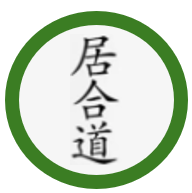MANNER
General Etiquette & Opening Formalities
When performing demonstrations (Enbu) before the altar in the dojo, it is important to follow the manner as described below. The same manner should be observed when you perform before the image of deceased ones, national fags or guests of honor.
Approach the area in which you will participate, the Shutsujo, with the sword in the Keito Shisei (sword carrying) posture and bow to the altar (Shinza E No Rei). Taking up a diagonal direction to the altar (Enbu No Hoko) , sit down in Seiza, place the sword in front of you and bow to it (Hajime No To Rei). Take up the sword again, insert it into your belt (Taito) and perform the exhibition. When you have finished, sit down once again, take out the sword and place it in front of you and bow to it (Owari No Torei). Then pick up the sword, stand up and bow to the altar, (Shinza E No Rei) and then leave the area (Taijo).
1. KEITO SHISEI (How to hold the sword)
Put your left thumb on the sword guard (Tsuba) whilst gripping the moulh of the sheath (Koiguchi) together with the cord (Sageo) in the other four fingers. The left arm should be slightly bent at the elbow. Hold the sword edge up, placing the pommel (Tsukagashira) towards the cenlerline of your abdomen. Point the tip of the scabbard (Kojiri) to a 45 degree angle and place the base of the left thumb on the hip-bone. The right hand should be placed along the side of the body in a straight vertical line.

2. SHUTSUJO (Entering the area)
Proceed to the area commencing with your right foot carrying your sword in Keito Shisei. Before proceeding, make sure the retaining peg (Mekugi) is firmly in place, your attire is correct and the Obi (belt) is suitably adjusted.
3. SHINZA E NO REI (Bow to the altar)
In Keito Shisei, stand upright facing the altar. Bring the left hand across the front of the body to the right side, around the level of the hip, changing the sword into your right hand. Grip the cord holder (Kurigata) and the Sageo, with your right hand. Place the blade edge down with the Tsukagashira at the rear. Release your left hand from the sword and return it naturally to your left side. Put the sword along your right side. Bend and incline your upper body forwards about 30 degrees and bow respectfully. After bowing, bring your right hand back across the front of your body at navel height, change hands and hold the sword guard with your left thumb and return to Keito Shisei
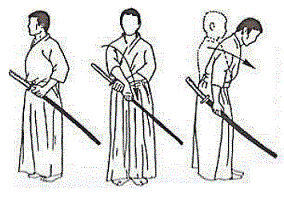
● Before bowing the Shomen, the heels of the feet should be joined together as the sword is brought to the right side; for example, just before the Rei, and can be returned to a natural position when the sword returns to the left hip in Taito shisei.
4. ENBU NO HOKO (Direction to face when performing)
Rotating your body in the direction of your right foot, locate yourself diagonally to the right of the altar holding your sword in Keito Shisei. You should be in a position such that the Shinza is to your left diagonaL This direction will become the front (Shomen) for the Enbu.
5. HAJIME NO TOREI (Bow to the sword before the performance)
From Keito Shisei, sit down (a); place the sword to the right (b), from Seiza (c) bow to the sword (d).
a] CHAKUZA (Sitting down)
From Keito Shisei, without withdrawing either foot, slightly open and bend both knees and while tucking the hem of the Hakama with the palm of the right hand, place the left knee, followed by the right on the floor. Leave about 10 cm of space between both knees. Extend the tips of your toes and put them side by side. Sit down quietly in a natural manner. Put your right lr ll tHI on the right thigh with the fingers lightly extended. Hold the sword in your left hand on the left thigh.
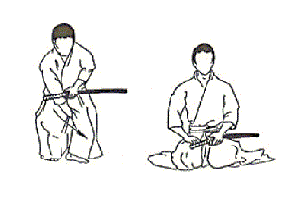
b] KATANA NO OKIKATA (How to place the sword)
With your left hand push the sword forward until the Tsuba is in line with the center of the body. As your right hand takes the sword, put your right thumb on the sword guard. Hold the Saya with the other four fingers close to the Koiguchi. Making sure the edge of the blade faces the front, extend both arms forwards at the same time, ensuring you keep the Sageo and Saya together. Hold near to the end of the Saya with your left hand from above. Bend your upper body forward and lay the sword in front of you. Be careful nol to let the end of the Saya point towards the altar. Sageo Sabaki may or may not be performed. Return your upper body to its original position and put your right hand followed by the left back on your thighs. Sit calmly while in Seiza.
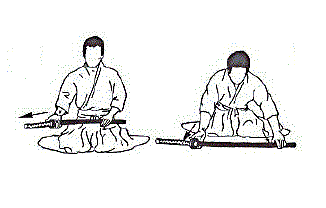
c] SEIZA NO SHISEI (Sitting posture)
,Jlraighten your back and concentrate your whole strength in the abdomen. Relax your shoulders and naturally push out your chest. Straighten the back of your neck and head. Put both hands on your thighs. Look 4-5 meters in front of you. Half open your eyes and show Enzan No Metsuke (looking at distant mountains). Be aware of all around you.

d] ZAREI (Bow)
Bend your upper body forward whilst in the sitting position. Place your left hand then the right on the floor before the sword and make a small triangle with thumbs and forefingers touching. Continue to bow until your elbows naturally touch the floor. Your feeling should be one of deep respect. When you have done this, naturally raise yourself up and return your right hand then left back to your thighs.
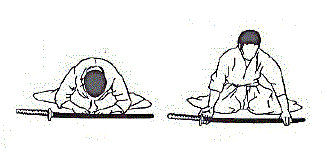
6. TAITO (Wearing the sword)
After the Hajime No Torei, you will be spiritually united with the sword. Incline your upper body forwards and take the sword with Sageo in both hands. With the right palm up take hold of the Saya near the Koiguchi.
Put the right thumb on the sword guard and at the same time place your left hand about 10 em from the end of the Saya and hold it lightly. As you raise yourself up bring the tip of the Saya to the center of your abdomen and insert the sword into the Obi. Arrange the sword so that its guard is in front of your navel. Secure the Sageo by tying it to the Hakama and return both hands to your thighs.
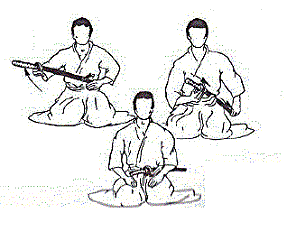
7. OWARI NO TOREI (Bow to the sword after the performance)
After completion of the Enbu, sit in Seiza and remove the sword (a), place the sword with the handle (Tsuka) to the left onto the floor and bow (b), place the sword on your thigh (c) and stand up (d).
a] DATTO (Removing the sword)
While sitting in Seiza with the sword in the Obi, pull and release the Sageo knot with the hand only. Place the left hand on the Saya near the Koiguchi ensuring your left thumb is on the sword guard. Slightly push the sword forward to the right front, until the left hand is in your center. Put the right forefinger on the sword guard and place the remaining fingers around the Koiguchi. Place your left hand on the left side of your hip on the Obi and by extending the right elbow pull out the sword. Make sure that the edge of the blade is facing you.

b] KATANA NO OKIKATA TO ZAREI (How to place the sword and bow)
Keeping the left hand on the left hip, with your right hand place the sword upright on the floor at your right front to your right knee and softly lay it down to lie in front of you so that is horizontal. Ensure the Sageo is tidy and that the blade edge is facing you. Put both hands on your thighs (right then left) and take Seiza no Shisei. Perform Zarei (see 5d) and return to Seiza.

c] KATANA NO TORIKATA (How to pick up the sword)
Leave your left hand on the left thigh, stretch out your right hand and put the forefinger on the Tsuba whilst placing the other four fingers around the Saya close to the Koiguchi. Keeping the edge of the blade towards yourself, lightly lift the sword to your center. Move the left hand to the center of the saya and squeeze it gently as it moves downwards to the tip. With both hands place the sword on your left thigh.
Release your right hand from the sheath, put the left thumb on the right inside of the sword guard and grip the mouth of the Saya with the remaining fingers. Hold the sword on your left thigh with your left hand and place the right hand back on your right thigh.
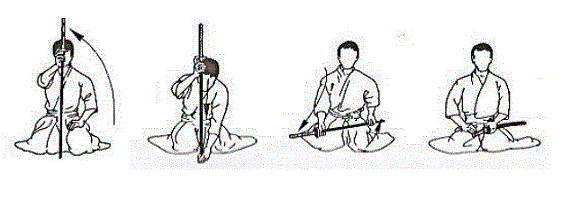
d] TACHI AGARI KATA (How to stand up)
Raise your waist up bringing your toes underneath. Place your right foot in line with your left knee and stand up without bending forwards. When you stand up bring your left foot in line with the right to assume Keito Shisei.
8. TAIJO (Leaving the area)
Stand in Keito Shisei and face the altar. Pass the sword from the left hand to the right across the front of your body and do Shinza E No Rei. Return the sword to the left hand back into Keito Shisei. Take three steps back starting with the left foot and make a 180 degrees right turn and leave the area.
MANNER
Additional explanations
1. How to step and turn when you arrive and leave the Shinden area.
When you perform in the Shinden (shrine, sacred place or Dojo) you enter the area from Shimo No Ashi (1) and leave there from Kami No Ashi (2). When you change your direction you turn to Kami No Ashi.
(1) Shimo No Ashi (S): the foot further from the Shinza (shrine) or Kamiza (lop seat). If you are on the center line (Seichusen) it is your left foot.
(2) Kami No Ashi (K): the foot nearer to the Shinza or Kamiza. If you are on the center line (Seichusen) it is your right foot.
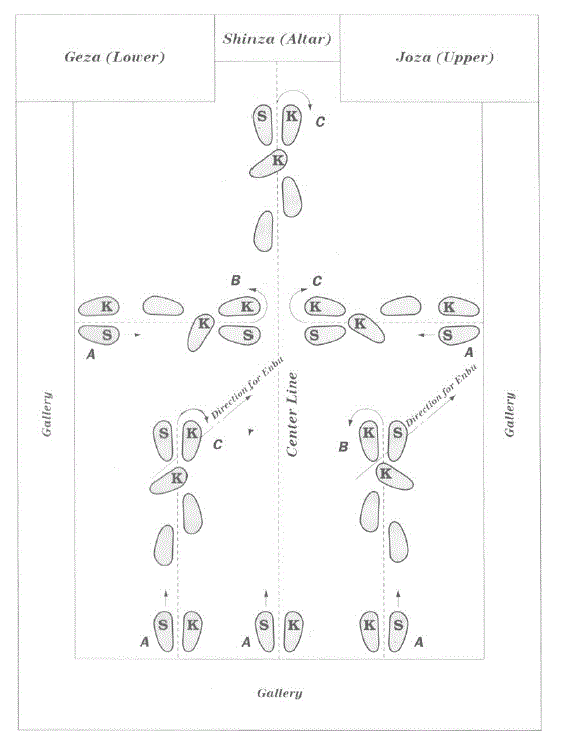
Shimo No Ashi is shown by S and Kami No Ashi by K.
A: Step forward with S.
B: On the return, step K back and turn anti-clockwise with S.
C: On the return, step K back and turn clockwise with S.
2. SHINZA E NO REI in Shinden (Bowing to the Shinza)
Proceed to the Shinza in Keito Shisei and do Chakuza as explained in Manner 3. With your left hand push the sword on your left thigh to the right front and bring your right hand to the inside of your left hand. Place your right forefinger on the sword guard and hold the Koiguchi together with the cord and the other four fingers. Transfer the sword to your right hand. While placing your left hand on the left thigh, move the tip of the Saya (Kojiri) from left rear to right rear with your right hand. Ensure the blade faces inside and put the sword guard in line with your knees. Place the sword quietly on the floor parallel with your right leg. Leave a space between your thigh and the sword. Release the right hand from the sword and bring it back to the right thigh. According to the style described in the Manner section do Zarei. After you have finished return the sword to the original position by doing everything in reverse order.
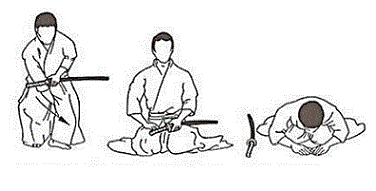
3. SOOGO NO ZAREI (Bow to each other)
This is similar to Shinza E No Rei, but meant as a sign of respect to the teachers and seniors. You start your bow first and raise your upper body after them.
4. YAGAI DE NO TOREI (Bow to the sword whilst standing)
From the Keito Shisei posture and the Sageo held folded in the left hand, move your left hand to the center of your body and bring your right hand to the inner side of your left hand. Put your right thumb on the sword guard and hold it near the mouth of the Koiguchi together with the folded Sageo (cord) in the other four fingers.
Ensure the blade faces away from you and extend both arms naturally to your front, level with your eyes. As you hold the sword up in front of you, incline the upper body forwards and bow respectfully. Hajime No Torei finishes with Taito by bringing the tip of the sheath to the center of your abdomen and Owari No Torei finishes with Keito Shisei by bringing the sword to the side of the left waist at the hip.
5. SAGETO SHISEI (Standing holding the sword posture)
Hold the Koiguchi and the cord (Sageo) lightly with your left hand. Ensure the blade edge is facing up. Hold the sword naturally with your left arm extended at the side with the Kojiri pointing down to the rear. You use this Kamae when are standing in a relaxed posture (Yasume).
6. How to perform ENBU (Performance)
It is important to perform the Enbu in full spirit, with correct handling of the sword and posture. Make efforts to show harmonization of spirit, sword and body. Devote yourself to perform earnestly as if you were in a real sword battle.
7. KOKYU (Breathing)
Every time you begin a new Kata you should start the action after the third breath. It is preferable to finish one performance in one breath. If this is difficult, endeavor not to show your breathing to the opponent.
8. How to hold the Tsuka
Hold the Tsuka near the sword guard with your right hand. Hold the other end with your left hand. Be careful not to hold the very end and to ensure that the left little finger does not touch the Makidome (final knot of the Tsuka binding near the end of the handle).
Apply a firmer grip to the lower finger muscles than the upper ones and hold the hilt firmly with your little finger and the third finger. The other fingers should be kept quite relaxed. Try to imagine that you are holding an egg. The palms of both hands should be in contact with the hilt of the sword.
9. Sageo (Cord)
It is a rule to tie a cord (Sageo) to the Saya. It is up to the individual schools how to tie or how to handle the cord. In some cases you may not require a cord.
3 Ways to Grip the Tsuka
● Calmly: Kata 1 and 2.
● When placing the left foot: Standing katas.
● Quickly: Kata 3, 4, and 12.
